Uranus
Uranus (pronounced YUR-uh-nus), so far away that it is virtually invisible to the naked eye, was the first planetary system discovered by a telescopic search of the heavens. The planet is 19.2 AU from the Sun and takes 84 Earth years to orbit it. Since its discovery in 1781, Uranus has orbited the Sun fewer than 3 times.
8-14 Uranus sports a hazy atmosphere and clouds
Until early 1996, observations of Uranus, the fourth most massive planet in our solar system, revealed few notable features in the visible part of the spectrum. Even the 1986 visit of Voyager 2 showed a remarkably bland world. It took the Hubble Space Telescope’s infrared camera to find what Voyager’s visible light camera could not: Uranus has a system of belts and zones. Its hydrogen atmosphere has traces of methane along with a high-altitude haze, under which are clear air and ever-changing methane clouds that dwarf the typical cumulus clouds we see on Earth. Uranus’s clouds are towering and huge, each typically as large as Europe. Along with the rest of the atmosphere, the clouds go around the planet once every 16½ hours, with variation due to differential rotation, as also occurs on Jupiter and Saturn.
Uranus contains 14½ times as much mass as Earth and is 4 times bigger in diameter (Figure 8-34). Its outer layers are composed predominantly of gaseous hydrogen and helium. The temperature in the upper atmosphere of the planet is so low (about 73 K, or −330°F) that the methane and water there condense to form clouds of ice crystals. Because methane freezes at a lower temperature than water, methane forms higher clouds over Uranus than does the water vapor. Methane efficiently absorbs red light, while scattering blue and green, thereby giving the planet its blue-green color.
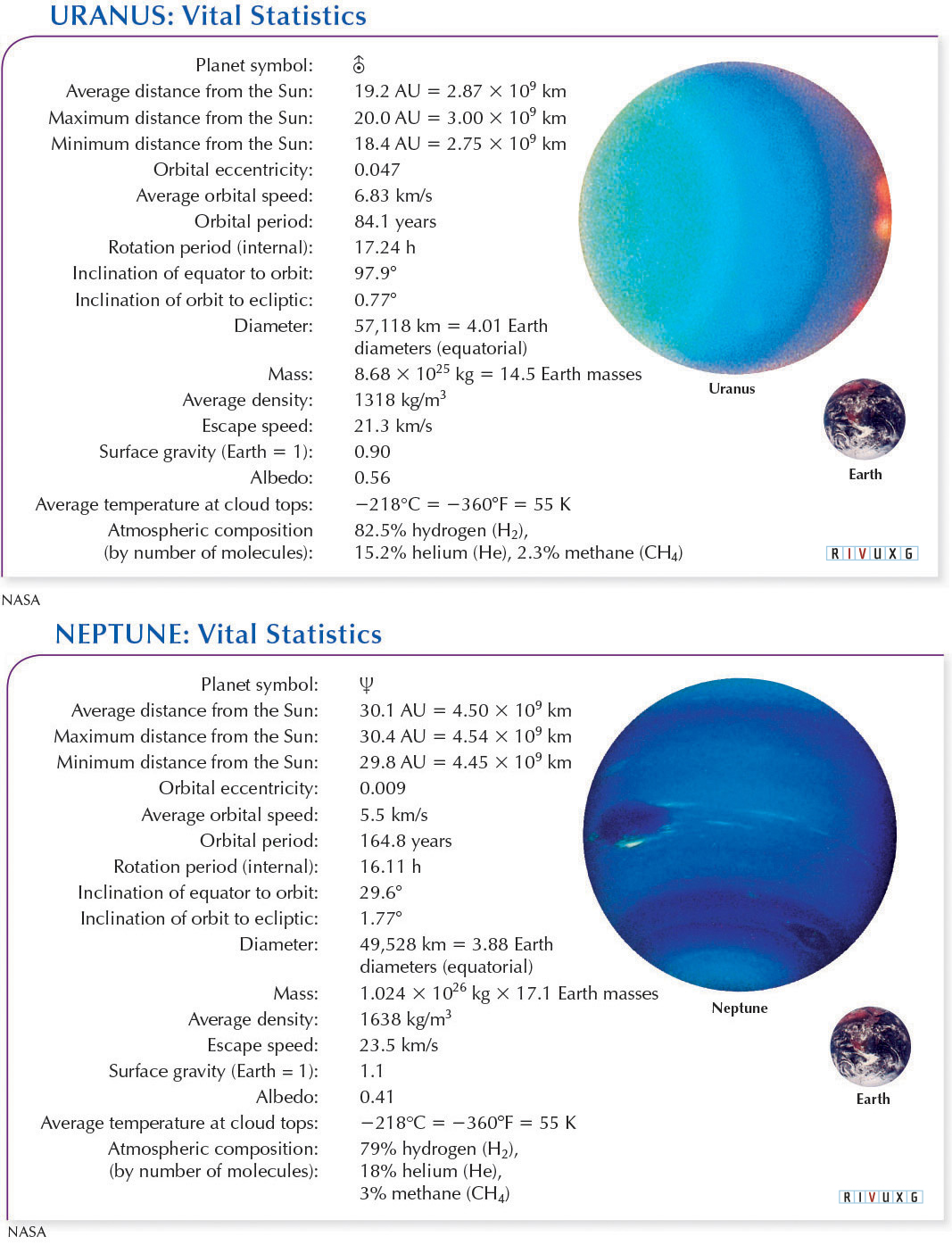
260
261
Uranus’s rotation axis lies very nearly in the plane of its orbit around the Sun (Figure 8-35). Put another way, recall that Earth’s rotation axis is tilted about 23½° from being perpendicular to the ecliptic. Uranus’s rotation axis is inclined 98° from a line perpendicular to its plane of orbit (see lower-left drawing in Figure 8-35). Therefore, its rotation axis lies within 8° of the plane of orbit.
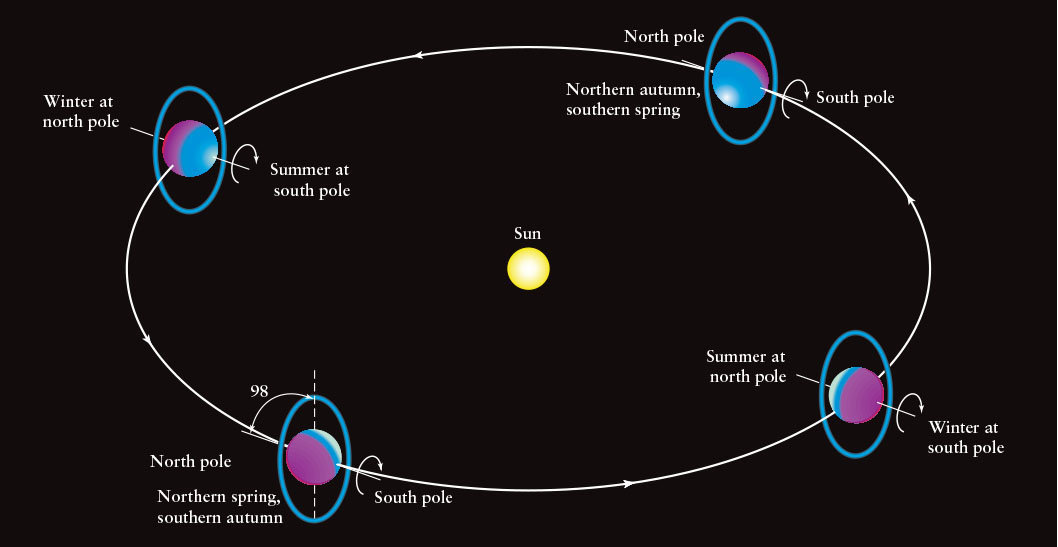
 Exaggerated Seasons on Uranus Uranus’s axis of rotation is tilted so steeply that it lies nearly in the plane of its orbit. Seasonal changes on Uranus are thus greatly exaggerated compared to those we experience. For example, during midsummer at Uranus’s south pole, the Sun appears nearly overhead for many Earth years, during which time the planet’s northern regions are subjected to a long, continuous winter night. Half an orbit later, the seasons are reversed.
Exaggerated Seasons on Uranus Uranus’s axis of rotation is tilted so steeply that it lies nearly in the plane of its orbit. Seasonal changes on Uranus are thus greatly exaggerated compared to those we experience. For example, during midsummer at Uranus’s south pole, the Sun appears nearly overhead for many Earth years, during which time the planet’s northern regions are subjected to a long, continuous winter night. Half an orbit later, the seasons are reversed.
Because its north pole points below the plane of its orbit around the Sun, Uranus is one of only two planets with retrograde rotation (Venus is the other). As Uranus orbits the Sun, its north and south poles alternately point almost directly toward or directly away from the Sun, producing exaggerated seasons (see Figure 8-35). In the summertime, near Uranus’s north pole, the Sun is almost directly overhead for many Earth years, at which time southern latitudes are subjected to a continuous, frigid winter night. Forty-two Earth years later, the situation is reversed. For more on this, see the essay “What If…Earth’s Axis Lay on the Ecliptic?” at the end of Chapter 1.
From Voyager photographs, planetary scientists have concluded that each of the five largest Uranian moons has probably had at least one shattering impact. A catastrophic collision with an Earth-sized object may also have knocked Uranus on its side, as we see it today.
From its mass and density (1318 kg/m3), astronomers conclude that Uranus’s interior has three layers. The outer 30% of the planet is liquid hydrogen and helium, the next 40% inward is highly compressed liquid water (with some methane and ammonia), and the inner 30% is a rocky core (Figure 8-36). Ammonia dissolves easily in water, so an ocean would explain the scarcity of this gas in the planet’s atmosphere. Because Uranus and Neptune are so rich in water, they are called ice giants.
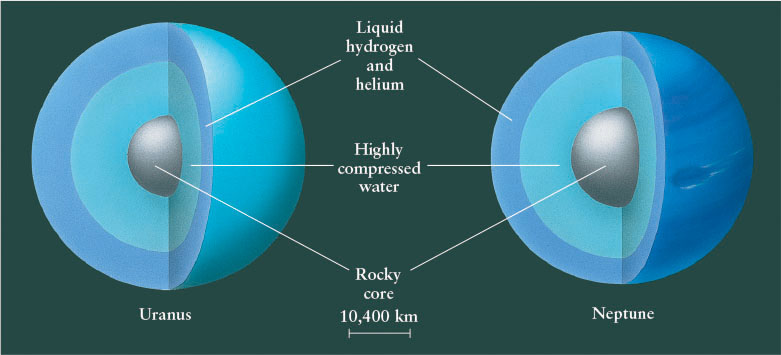
Uranus’s surface magnetic field is about three-quarters that of Earth. That strength is reasonable, considering the planet’s mass and rotation rate, but everything else about the magnetic field is extraordinary. The field is remarkably tilted—59° from its axis of rotation—and its axis does not even pass through the center of the planet (Figure 8-37).
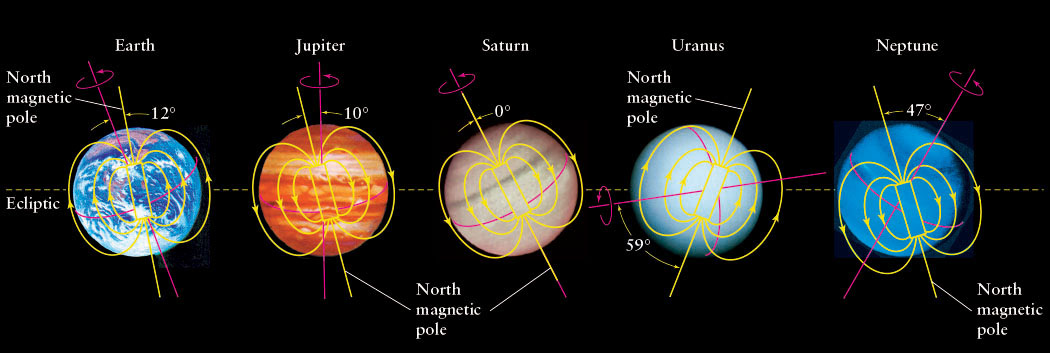
Margin Question 8-12
Question
Besides a terrestrial world, what dominates the composition of Uranus’s interior?
The magnetosphere of Uranus wobbles considerably as the planet rotates because of the large angle between the magnetic field of Uranus and its rotation axis. A rapidly changing magnetic field like this occurs elsewhere in astronomy. For example, it helps explain the behavior of pulsars, a type of stellar remnant we will study in Chapter 13. Astronomers use Uranus’s magnetosphere’s wobble to determine that the planet’s interior rotates once every 17 hours 14 minutes. This is considerably slower than the 16½ hour rotation rate of the clouds on its surface.
262
8-15 A system of rings and satellites revolves around Uranus
Uranus has 15 known rings, each divided into ringlets (Figure 8-38). The first nine of the thin, dark rings were discovered accidentally in 1977 when Uranus passed in front of a star. The star’s light was momentarily blocked by each ring, thereby revealing their existence to astronomers (Figure 8-39). Blocking of the light of a more distant object, such as the star here, by something between it and us, such as Uranus’s rings, is called an occultation. The other rings were detected by Voyager and the Hubble Space Telescope. The rings are held in orbit by shepherd moons, including Cordelia and Ophelia.
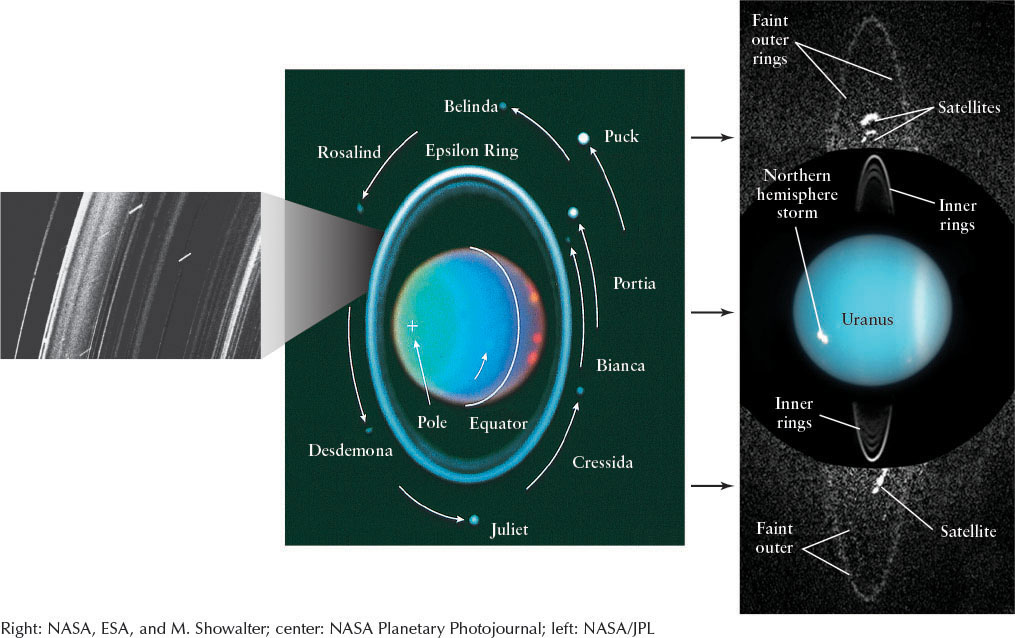
 The Rings and Moons of Uranus (Right) Full-scale image of Uranus and its inner and outer rings. (Center) This image of Uranus, its rings, and eight of its moons was taken by the Hubble Space Telescope. (Left) Close-up of part of the ring system taken by Voyager 2 when the spacecraft was in Uranus’s shadow looking back toward the Sun. Numerous fine dust particles between the main rings gleam in the sunlight. The short streaks are star images blurred because of the spacecraft’s motion during the exposure.
The Rings and Moons of Uranus (Right) Full-scale image of Uranus and its inner and outer rings. (Center) This image of Uranus, its rings, and eight of its moons was taken by the Hubble Space Telescope. (Left) Close-up of part of the ring system taken by Voyager 2 when the spacecraft was in Uranus’s shadow looking back toward the Sun. Numerous fine dust particles between the main rings gleam in the sunlight. The short streaks are star images blurred because of the spacecraft’s motion during the exposure.
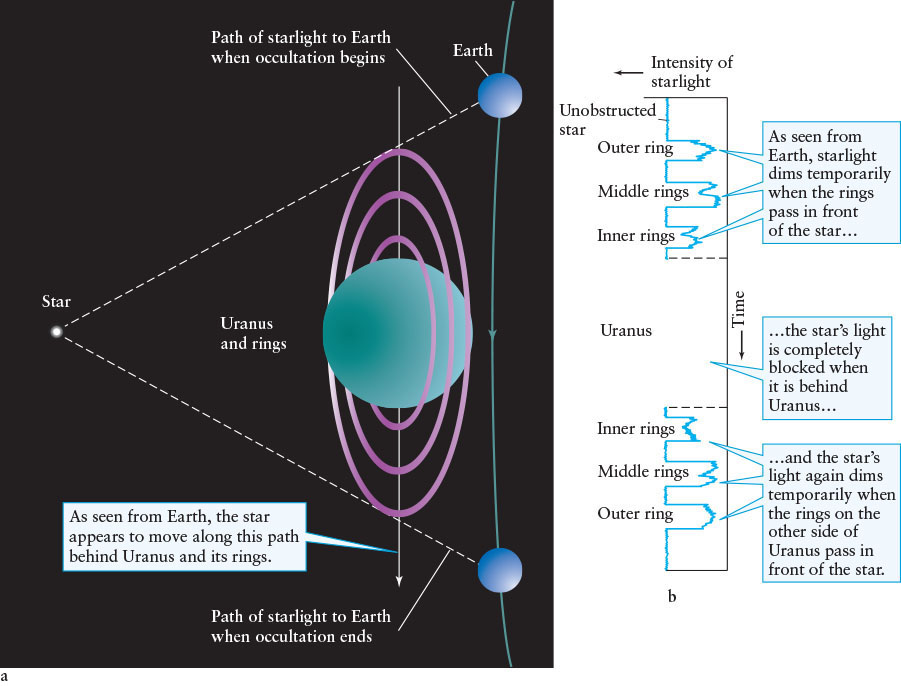
Most of Uranus’s 27 known moons, like its rings, orbit in the plane of the planet’s equator, that is, nearly perpendicular to the plane of the ecliptic. The moons were forced into these unusual orbits from whatever their original orbits may have been by the tides they created on the planet. These tides pulled back on the moons and caused them to change orbital direction until they were over Uranus’s equator, where they have been ever since. Five of these satellites, ranging in diameter from 480 to nearly 1600 km, were known before the Voyager mission. Voyager’s cameras discovered 10 additional satellites, each smaller than 50 km across. Still others have since been observed from Earth. Several of these tiny, irregularly shaped moons are among the shepherd satellites.
Comparing observations taken 30 years apart, between the 1970s and the first decade of the twenty-first century, reveals that the moons in the vicinity of the rings are changing orbits due to their mutual gravitational influences and the gravitational tugs of the rings. Furthermore, some of the ring debris is being lost and replaced by debris blasted off the moons as a result of meteorite impacts. Observations suggest that the moon Mab, discovered in 2003, is supplying the dust for the outermost ring.
263
264
Miranda is the most fascinating and bizarre of Uranus’s moons. Unusual wrinkled and banded features cover Miranda’s surface (Figure 8-40). Its highly varied terrain suggests that it was once seriously disturbed. Perhaps a shattering impact temporarily broke it into several pieces that then recoalesced, or perhaps severe tidal heating, as we saw on Io, moved large pieces of its surface.
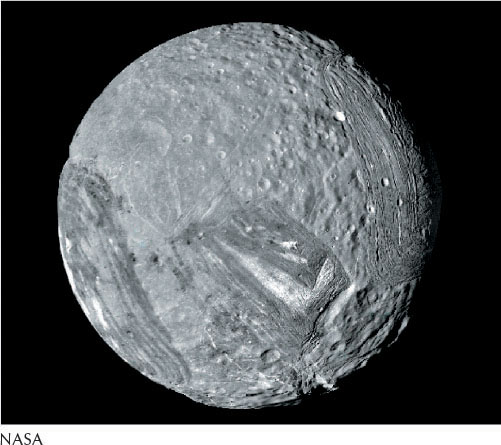
 Miranda The patchwork appearance of Miranda in this mosaic of Voyager 2 images suggests that this satellite consists of huge chunks of rock and ice that came back together after an ancient, shattering impact by an asteroid or a neighboring Uranian moon. The curious banded features that cover much of Miranda are parallel valleys and ridges that may have formed as dense, rocky material sank toward the satellite’s core. At the very bottom of the image—where a “bite” seems to have been taken out of the satellite—is a range of enormous cliffs that jut upward as high as 20 km, twice the height of Mount Everest.
Miranda The patchwork appearance of Miranda in this mosaic of Voyager 2 images suggests that this satellite consists of huge chunks of rock and ice that came back together after an ancient, shattering impact by an asteroid or a neighboring Uranian moon. The curious banded features that cover much of Miranda are parallel valleys and ridges that may have formed as dense, rocky material sank toward the satellite’s core. At the very bottom of the image—where a “bite” seems to have been taken out of the satellite—is a range of enormous cliffs that jut upward as high as 20 km, twice the height of Mount Everest.
Margin Question 8-13
Question
Why do Uranus’s rings remain in orbit?
Miranda’s core originally consisted of dense rock, while its outer layers were mostly ice. If a powerful impact did occur, blocks of debris broke off from Miranda and then drifted back together through mutual gravitational attraction. Recolliding with that moon, they formed a chaotic mix of rock and ice. In this scenario, the landscape we see today on Miranda is the result of huge, dense rocks trying to settle toward the satellite’s center, forcing blocks of less dense ice upward toward the surface.